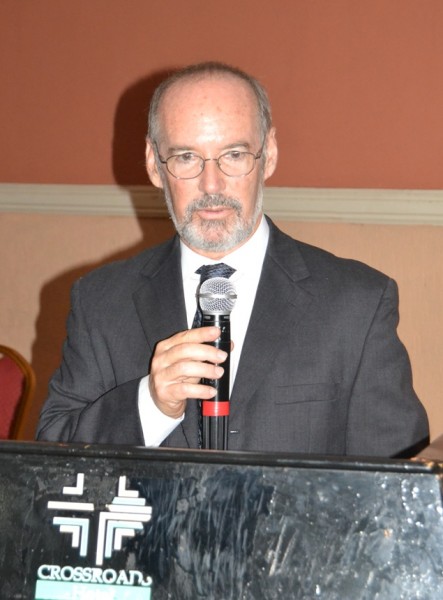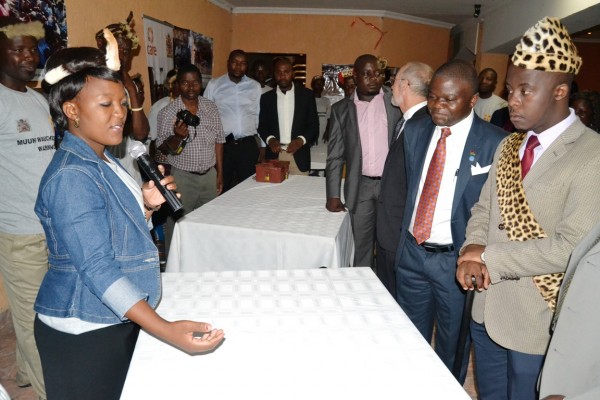![Minister of Health, Peter Kumpalume being briefed on entourage view display from Maditsietsi Chimwala Pama, Secretary for Madalitso Youth Club at Nsiyaludzu, Ntcheu-(c) Abel Ikiloni.]()
Minister of Health, Dr Peter Kumpalume has said Malawi has managed to meet World Health Organization (WHO) standards on reducing child mortality rate.
[caption id="attachment_101891" align="alignright" width="443"]
![CARE Country Director, Michael Rewald gives his welcome remarks at Dissemination Programme of Muuni Wauchembere Wabwino at Crossroads Hotel-(c) Abel Ikiloni]()
CARE Country Director, Michael Rewald gives his welcome remarks at Dissemination Programme of Muuni Wauchembere Wabwino at Crossroads Hotel-(c) Abel Ikiloni[/caption]
[caption id="attachment_101889" align="alignright" width="600"]
![Kumpalume deliver his speech-(c) Abel Ikiloni, Mana]()
Kumpalume deliver his speech-(c) Abel Ikiloni, Mana[/caption]
[caption id="attachment_101890" align="alignright" width="600"]
![Minister of Health, Peter Kumpalume being briefed on entourage view display from Maditsietsi Chimwala Pama, Secretary for Madalitso Youth Club at Nsiyaludzu, Ntcheu-(c) Abel Ikiloni.]()
Minister of Health, Peter Kumpalume being briefed on entourage view display from Maditsietsi Chimwala Pama, Secretary for Madalitso Youth Club at Nsiyaludzu, Ntcheu-(c) Abel Ikiloni.[/caption]
Kumpalume disclosed this in Lilongwe during a dissemination workshop on Muuni wa Uchembere Wambino, an initiative on sexual and reproductive health by Care Malawi.
“We started taking closer interest in maternal death and child mortality rates since the onset of Malawi Development Growth Strategy (MDGSs) in 2000 and in 2004, 76, 000 children died per 100, 000 children which were quite high,” Kumpalume explained.
He added that government targeted to bring down child mortality rate figures and they managed to reach WHO standards and the MDGs that were set.
Kumpalume however said Malawi has failed to meet the target on maternal deaths, but managed a 50 per cent reduction and his ministry has plans to improve so that there should be no unnecessary deaths occurring during child birth.
He said government has put measures that no pregnant mother delivers at home and attend health clinics and wait at health facilities to deliver in the hands of skilled birth attendants to avoid child and mother deaths.
Kumpalume also said it was encouraging that traditional leaders were taking lead in reducing child and marternal deaths citing the case of Ntcheu district.
Care Malawi, Country Director, Michael Rewald said if the dialogue between health users and service providers improves, the out-come on maternal and new born deaths would likely improve as well.
He said his organization was pleased to know that there was an improvement in child mortality rate in Malawi.
According to the summary of key findings in Ntcheu by Care Malawi, both health workers and community members who participated on Community Score Card (CSC) process found twelve indicators that were improving.
Reads part of the findings, “We analysed the indicator scores for the first and last CSC cycles and found that all twelve indicators showed improvement which included; level of youth participation, commitment of service provides, level of male involvement, relationship between health workers and communities, reception of clients at the facility, availability and accessibility of information and availability of transport to the health facility during delivery among others.”
Inkosi ya Makosi Gomani V said Ntcheu district has done well because men also take part in encouraging women to deliver at health facilities to reduce both child and maternal deaths.
He said the youth have also been empowered to take part in issues of sexual reproductive health.
Gomani added that they have also increased knowledge of people in the district in the areas of maternal health.
Care Malawi started the Maternal Health Alliance Project (MHAP) in 2012 to improve maternal, newborn and reproductive health in Ntcheu.
--Mana

 CARE Country Director, Michael Rewald gives his welcome remarks at Dissemination Programme of Muuni Wauchembere Wabwino at Crossroads Hotel-(c) Abel Ikiloni[/caption]
[caption id="attachment_101889" align="alignright" width="600"]
CARE Country Director, Michael Rewald gives his welcome remarks at Dissemination Programme of Muuni Wauchembere Wabwino at Crossroads Hotel-(c) Abel Ikiloni[/caption]
[caption id="attachment_101889" align="alignright" width="600"] Minister of Health, Peter Kumpalume being briefed on entourage view display from Maditsietsi Chimwala Pama, Secretary for Madalitso Youth Club at Nsiyaludzu, Ntcheu-(c) Abel Ikiloni.[/caption]
Kumpalume disclosed this in Lilongwe during a dissemination workshop on Muuni wa Uchembere Wambino, an initiative on sexual and reproductive health by Care Malawi.
“We started taking closer interest in maternal death and child mortality rates since the onset of Malawi Development Growth Strategy (MDGSs) in 2000 and in 2004, 76, 000 children died per 100, 000 children which were quite high,” Kumpalume explained.
He added that government targeted to bring down child mortality rate figures and they managed to reach WHO standards and the MDGs that were set.
Kumpalume however said Malawi has failed to meet the target on maternal deaths, but managed a 50 per cent reduction and his ministry has plans to improve so that there should be no unnecessary deaths occurring during child birth.
He said government has put measures that no pregnant mother delivers at home and attend health clinics and wait at health facilities to deliver in the hands of skilled birth attendants to avoid child and mother deaths.
Kumpalume also said it was encouraging that traditional leaders were taking lead in reducing child and marternal deaths citing the case of Ntcheu district.
Care Malawi, Country Director, Michael Rewald said if the dialogue between health users and service providers improves, the out-come on maternal and new born deaths would likely improve as well.
He said his organization was pleased to know that there was an improvement in child mortality rate in Malawi.
According to the summary of key findings in Ntcheu by Care Malawi, both health workers and community members who participated on Community Score Card (CSC) process found twelve indicators that were improving.
Reads part of the findings, “We analysed the indicator scores for the first and last CSC cycles and found that all twelve indicators showed improvement which included; level of youth participation, commitment of service provides, level of male involvement, relationship between health workers and communities, reception of clients at the facility, availability and accessibility of information and availability of transport to the health facility during delivery among others.”
Inkosi ya Makosi Gomani V said Ntcheu district has done well because men also take part in encouraging women to deliver at health facilities to reduce both child and maternal deaths.
He said the youth have also been empowered to take part in issues of sexual reproductive health.
Gomani added that they have also increased knowledge of people in the district in the areas of maternal health.
Care Malawi started the Maternal Health Alliance Project (MHAP) in 2012 to improve maternal, newborn and reproductive health in Ntcheu.--Mana
Minister of Health, Peter Kumpalume being briefed on entourage view display from Maditsietsi Chimwala Pama, Secretary for Madalitso Youth Club at Nsiyaludzu, Ntcheu-(c) Abel Ikiloni.[/caption]
Kumpalume disclosed this in Lilongwe during a dissemination workshop on Muuni wa Uchembere Wambino, an initiative on sexual and reproductive health by Care Malawi.
“We started taking closer interest in maternal death and child mortality rates since the onset of Malawi Development Growth Strategy (MDGSs) in 2000 and in 2004, 76, 000 children died per 100, 000 children which were quite high,” Kumpalume explained.
He added that government targeted to bring down child mortality rate figures and they managed to reach WHO standards and the MDGs that were set.
Kumpalume however said Malawi has failed to meet the target on maternal deaths, but managed a 50 per cent reduction and his ministry has plans to improve so that there should be no unnecessary deaths occurring during child birth.
He said government has put measures that no pregnant mother delivers at home and attend health clinics and wait at health facilities to deliver in the hands of skilled birth attendants to avoid child and mother deaths.
Kumpalume also said it was encouraging that traditional leaders were taking lead in reducing child and marternal deaths citing the case of Ntcheu district.
Care Malawi, Country Director, Michael Rewald said if the dialogue between health users and service providers improves, the out-come on maternal and new born deaths would likely improve as well.
He said his organization was pleased to know that there was an improvement in child mortality rate in Malawi.
According to the summary of key findings in Ntcheu by Care Malawi, both health workers and community members who participated on Community Score Card (CSC) process found twelve indicators that were improving.
Reads part of the findings, “We analysed the indicator scores for the first and last CSC cycles and found that all twelve indicators showed improvement which included; level of youth participation, commitment of service provides, level of male involvement, relationship between health workers and communities, reception of clients at the facility, availability and accessibility of information and availability of transport to the health facility during delivery among others.”
Inkosi ya Makosi Gomani V said Ntcheu district has done well because men also take part in encouraging women to deliver at health facilities to reduce both child and maternal deaths.
He said the youth have also been empowered to take part in issues of sexual reproductive health.
Gomani added that they have also increased knowledge of people in the district in the areas of maternal health.
Care Malawi started the Maternal Health Alliance Project (MHAP) in 2012 to improve maternal, newborn and reproductive health in Ntcheu.--Mana